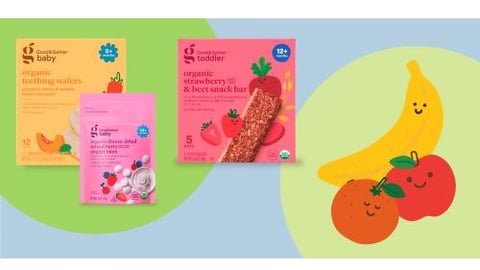Use Private Label Package Design to Improve Your Supermarket’s Customer Experience
Walk into a Loblaws supermarket in Canada, and you’re greeted with blocks of basic yellow-and- black packaging for the grocer’s private No Name brand – its steadfast symbol of value and quality for more than 40 years.
Next, shop the cozy aisles of your local Trader Joe’s and you’ll see a colorful and quirky assortment of products from Trader Ming’s, Trader Jacques’, Trader José’s and, yes, Trader Joe’s. In fact, nearly 80% of the products on Trader Joe’s shelves are private label brands.
[Read more: "Albertsons Leans Into Organic Breakfast Trends"]
These are two very different retailers – different in their approaches, retail formats, product offerings and private-brand strategies – but they’re both realizing similar success.
Loblaws is a more traditional grocer featuring numerous national brands while merchandising complex categories with a powerful private-brand portfolio. That portfolio leverages strong but consistent design to build a powerful brand image across the store. The bold yellow-and-black packaging makes a strong brand statement with an authoritative retail presence.
In contrast, specialty retailer Trader Joe’s offers unique store formats, no national-brand competition and merchandises items instead of categories. Its quirky products employ eccentric design that can vary widely per item.
Both retailers offer singular experiences for shoppers and are prime examples of how private label package design is evolving to positively impact customer experience in supermarkets.
Value Proposition
While you can stop nearly anywhere to grab a bottle of Coca-Cola, there’s only one retailer that enables you to grab that box of Simply Nature organic edamame spaghetti (Spoiler: It’s ALDI). Data consistently shows that higher private label penetration equals store loyalty. Customers can only get those yellow No Name products, the Trader Joe’s snacks and organic Simply Nature ingredients exclusively from those respective retailers.
Therein lies the value proposition of private label for retailers and the opportunity they present as a holistic tool to enhance the grocery shopping experience.
The more SKUs in a store that a retailer controls, the greater it can influence the shopping experience. When customers wander through a produce department that takes extra care stacking apples, they get the perception that the store has great produce.
Center store, whether private label is 10% or 80% of the product mix, store brands can perform the same role. When customers walk through a category, thoughtful private label package design and strategic merchandising can enhance the shopping experience, whether it’s block set or in a checkerboard.
Retailers are constantly testing new formats – bigger, smaller, more checkouts, self-checkouts, curbside pickup, etc. The only consistency is the constant shift. New, fresh designs for private label products can make the same impact with your customers.
In recalibrating your approach to private label, consider the following:
Think about private label packaging at more than just a category level. Because of the vastness of some private label brands, balancing brand awareness, shelf impact and category relevance can be a challenge. Designing a national-brand equivalent (NBE) brand that crosses more than 4,000 SKUs, for example, is a delicate brand-building, category dynamics and merchandising dance. It’s vital for retailers to step back and envision how the brand will show up across the store, how it grabs customer attention in a category and supports the overall go-to-market strategy.
Step out of the conference room and explore the retail environment. It’s a mistake to design a private-brand package without a keen understanding of where it will sit in-store, what it will stand next to on shelf, lighting and product competition. Would you purchase a sofa for your home without knowing how much space you have and without taking into account the color of the walls, carpet and lighting? Of course not.
It’s an entirely different experience to see a brand on the supermarket shelf than it is to see that same brand on a computer screen or printed on paper. The store is where customers formulate perceptions and make buying decisions, so your brand and merchandising teams should do so as well.
10-5-2 strategy. Employ a 10-5-2 strategy as a core step in the creative process. In short, ask, “Does the design have brand impact at 10 feet?” Then, “At 5 feet, is the design effectively communicating in its category?” Finally, “At 2 feet, are all the key features and benefits properly displayed on pack to help persuade consumers to purchase?”
This approach balances how the brand shows up at retail with the purchase intent. So, when it comes to private label products, thinking about how that private label shows up at the store from a design and merchandising perspective can greatly influence a customer’s overall perception of the retailer.
Keep an eye on the future. As sustainability continues to move to the forefront across every retailer’s business, private label packaging will continue to improve and change. Consider the shape of a Tetra Pak milk carton or a Heinz ketchup bottle, for example. That’s part of their brands. For private labels, there can be significant innovation in packaging structure and materials, using the physical package as a branding tool.
As branding becomes more of a strategic tool for retailers, packaging will follow. In turn, private label packaging design will continue to be pushed to higher standards.
Many retailers will say that they make more profit on private labels than on national brands, but that’s a financial decision versus a branding or marketing decision. Private labels are a strategic tool to build loyalty to your store and awareness of your brand.
When retailers create unique and differentiated products, it can take customer experience to the next level. Good design has experiential benefits. Private label design can be performed in a thoughtful, relevant way that can change the shopping experience for a consumer and retailer.






